Richard Nixon Worksheets
Do you want to save dozens of hours in time? Get your evenings and weekends back? Be able to teach about Richard Nixon to your students?
Our worksheet bundle includes a fact file and printable worksheets and student activities. Perfect for both the classroom and homeschooling!
Resource Examples
Click any of the example images below to view a larger version.
Fact File

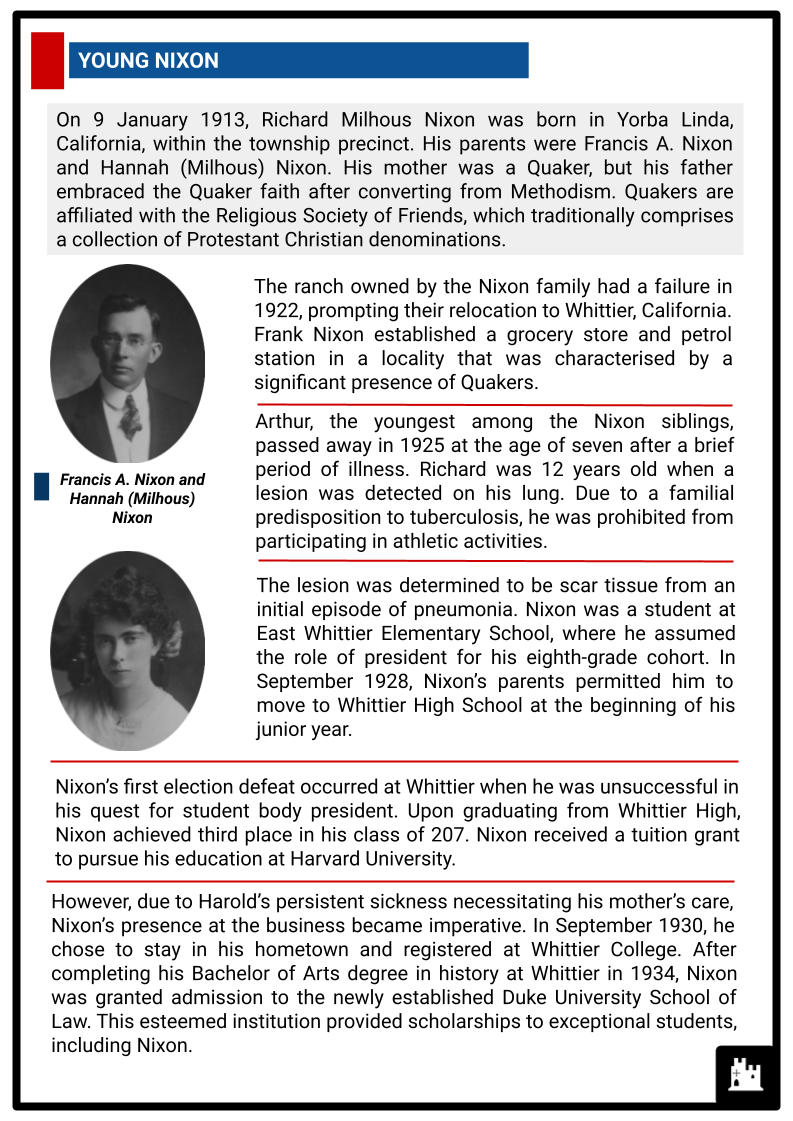
Student Activities
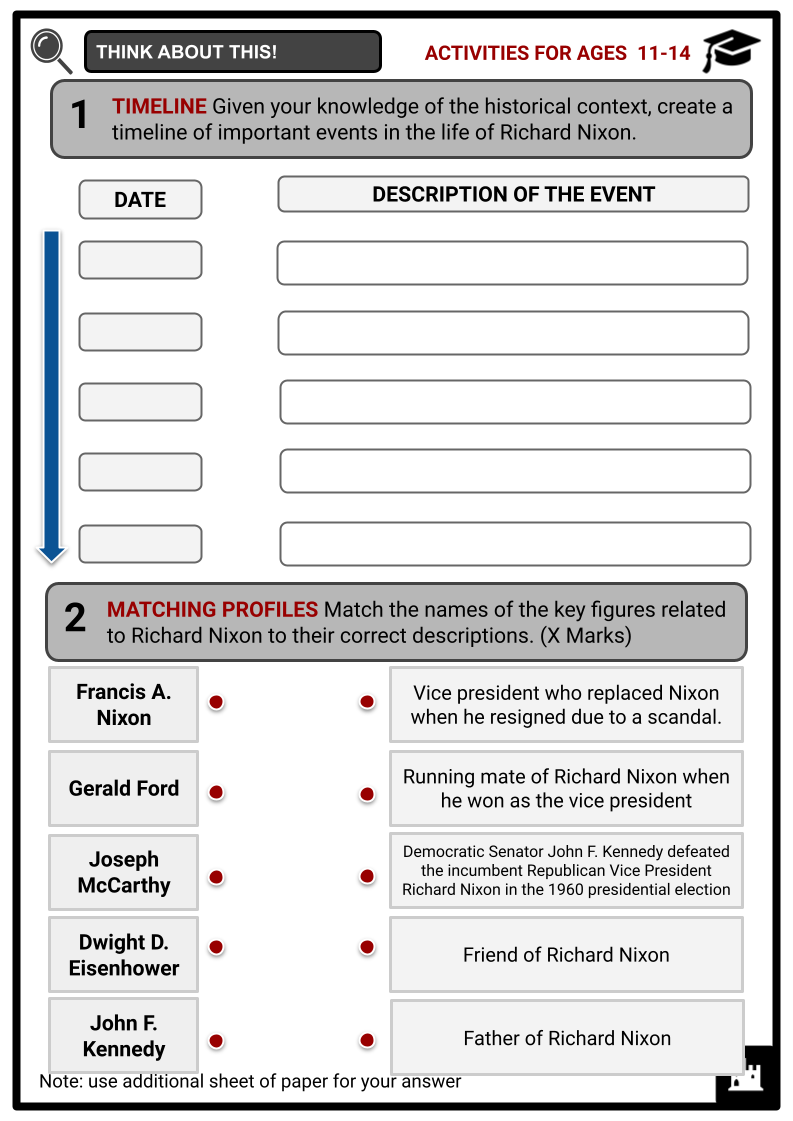
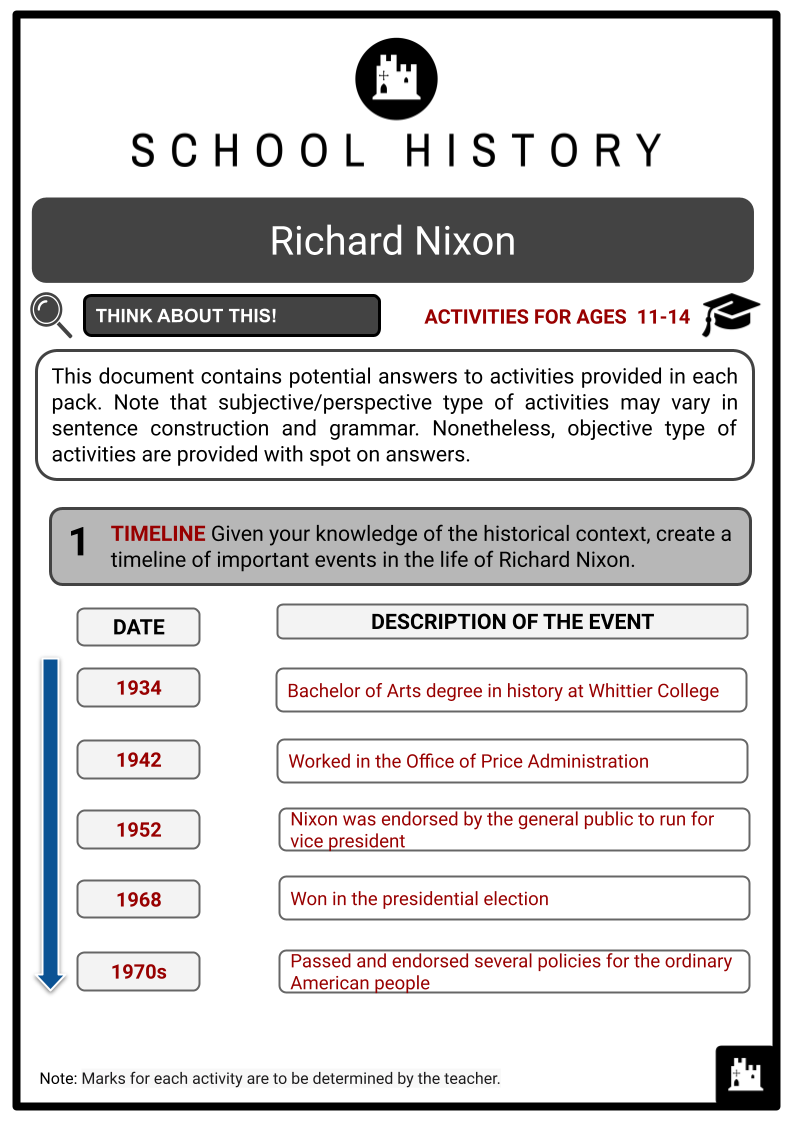
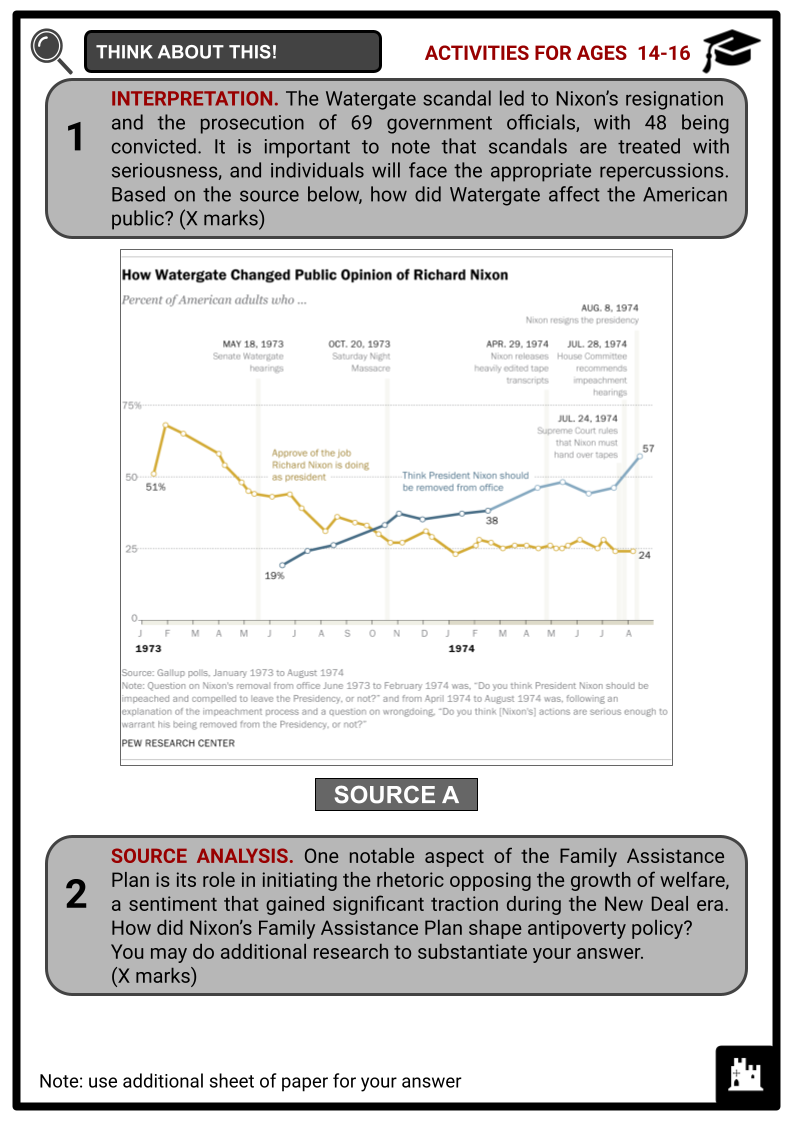
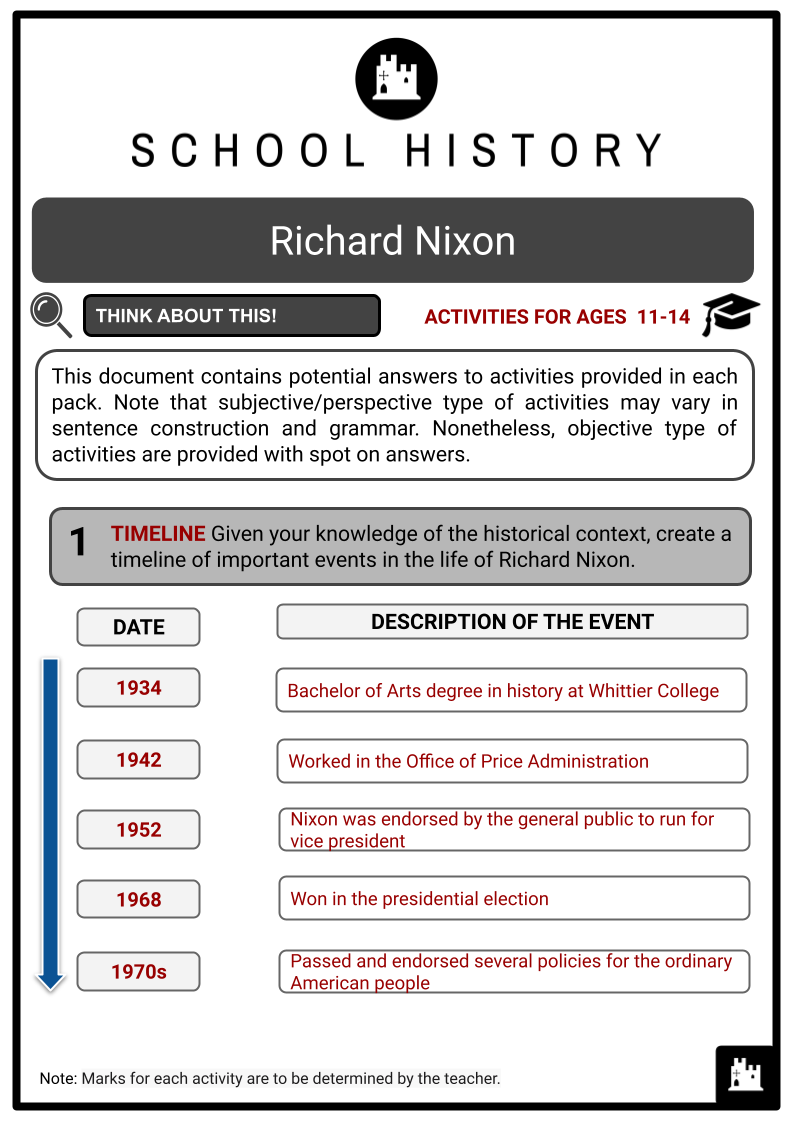
Summary
- Young Nixon
- Early Career and Marriage
- Nixon Presidency
- Watergate Scandal
- Life after Presidency
- Death
Key Facts And Information
Let’s know more about Richard Nixon!
Richard Nixon served as the 37th president of the United States from 1969 to 1974. In 1970, as a supporter of the conservation movement, he announced the formation of the Environmental Protection Agency (EPA), which protects human and environmental health. In 1972, his visit to China led to diplomatic relations between China and America. He was also able to end American involvement in the Vietnam War in 1973. Despite this, however, Nixon became the only president to resign from office following the Watergate scandal.
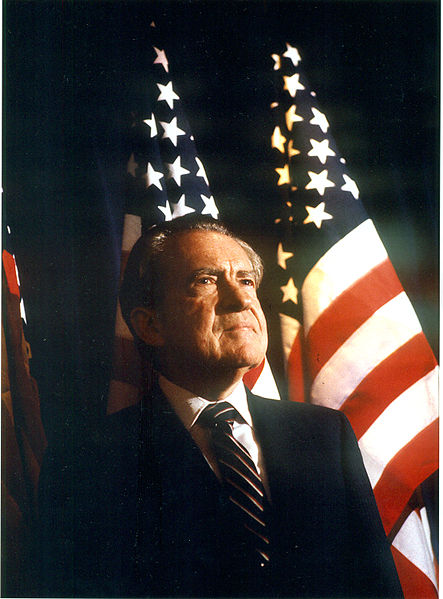
YOUNG NIXON
- On 9 January 1913, Richard Milhous Nixon was born in Yorba Linda, California, within the township precinct. His parents were Francis A. Nixon and Hannah (Milhous) Nixon. His mother was a Quaker, but his father embraced the Quaker faith after converting from Methodism. Quakers are affiliated with the Religious Society of Friends, which traditionally comprises a collection of Protestant Christian denominations.
- The ranch owned by the Nixon family had a failure in 1922, prompting their relocation to Whittier, California. Frank Nixon established a grocery store and petrol station in a locality that was characterised by a significant presence of Quakers.
- Arthur, the youngest among the Nixon siblings, passed away in 1925 at the age of seven after a brief period of illness. Richard was 12 years old when a lesion was detected on his lung. Due to a familial predisposition to tuberculosis, he was prohibited from participating in athletic activities.
- The lesion was determined to be scar tissue from an initial episode of pneumonia. Nixon was a student at East Whittier Elementary School, where he assumed the role of president for his eighth-grade cohort. In September 1928, Nixon’s parents permitted him to move to Whittier High School at the beginning of his junior year.
- Nixon’s first election defeat occurred at Whittier when he was unsuccessful in his quest for student body president. Upon graduating from Whittier High, Nixon achieved third place in his class of 207. Nixon received a tuition grant to pursue his education at Harvard University.
- However, due to Harold’s persistent sickness necessitating his mother’s care, Nixon’s presence at the business became imperative. In September 1930, he chose to stay in his hometown and registered at Whittier College. After completing his Bachelor of Arts degree in history at Whittier in 1934, Nixon was granted admission to the newly established Duke University School of Law. This esteemed institution provided scholarships to exceptional students, including Nixon.
EARLY CAREER AND MARRIAGE
- Upon completing his studies at Duke University, Nixon first aspired to become a member of the Federal Bureau of Investigation (FBI). He did not receive a reply to his application letter and later found that he had been appointed, but his employment was abruptly cancelled owing to budget reductions.
- In 1938, Nixon established an independent division of Wingert and Bewley in La Habra, California, and then assumed the role of a full partner within the company in the subsequent year.
- Nixon relocated to Washington, DC, in January 1942, where he secured employment at the Office of Price Administration. Nixon was assigned to the tyre-rationing division responsible for responding to electronic communication.
House of Representatives
- The Republicans representing the 12th congressional district in California expressed dissatisfaction with their failure to defeat Democratic incumbent Jerry Voorhis. Consequently, they endeavoured to identify a candidate who could garner consensus and effectively campaign against Voorhis.
- The suggestion was made by Herman Perry, the manager of Whittier’s Bank of America branch, for Nixon to contest the election against Voorhis. The election was won by Nixon, who garnered 65,586 votes in contrast to Voorhis’s 49,994 votes.
US Senate
- In 1949, Nixon started contemplating a candidature for the United States Senate, challenging the Democratic incumbent, Sheridan Downey. He officially joined the candidacy in November. In March 1950, Downey decided to retire due to the challenging primary competition he faced against Representative Helen Gahagan Douglas. Nixon and Douglas were victorious in the primary elections and embarked on a highly controversial campaign, with the continuing Korean War serving as a prominent focal point.
- During his time in the Senate, Nixon fought worldwide communism by regularly visiting different places and openly expressing disapproval of communism. He also had a good relationship with Joseph McCarthy, a fellow anti-communist. Although Nixon kept some distance from McCarthy due to controversials surrounding the latter.
- Nixon disapproved of President Harry S. Truman’s management of the Korean War. Nixon advocated for the incorporation of Alaska and Hawaii as states, cast his vote in favour of civil rights for minority groups, and backed federal assistance for India and Yugoslavia during natural disasters. He opposed price limits, monetary restrictions, benefits for illegal immigration, and state power.
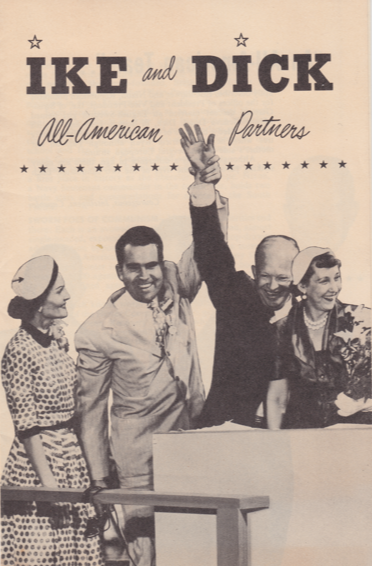
Vice Presidency
- In 1952, the Republicans nominated General Dwight D. Eisenhower for the presidency. He lacked a definitive inclination towards a vice-presidential candidate. Republican officeholders and party officials convened in a clandestine meeting and endorsed Nixon to the general public, who consented to the senator’s nomination.
- The leaders perceived Nixon’s relatively young age (39 at the time), solid anti-communist position, and political support in California, one of the most populous states, as factors that would attract votes.
- Dwight D. Eisenhower delegated more responsibilities to Nixon as vice president than his predecessors. Despite Nixon’s vigorous campaigning, where he reiterated his forceful criticisms of the Democrats, the Republicans relinquished control of both chambers of Congress in the 1954 elections.
- These setbacks prompted Nixon to consider retiring from politics after completing his term. President Eisenhower experienced a myocardial infarction on 24 September 1955, and his first prognosis was that his condition posed a significant risk to his life. Eisenhower was incapacitated for six weeks, rendering him unable to fulfil his responsibilities.
- Nixon’s vice presidency was marked by numerous high-profile international trips, such as his 1958 tour of Latin America, which journalist Walter Lippmann called a diplomatic Pearl Harbour.
- During this trip, Nixon’s car was attacked by anti-American protesters who threw stones, slapped and spat on it. Additionally, in 1959, Nixon visited the Soviet Union, where he engaged in an unplanned and heated exchange of profanities with Soviet Premier Nikita Khrushchev. This event became known as the ‘kitchen debate’.
NIXON PRESIDENCY
- In 1960, Nixon received the Republican presidential nomination and was opposed by Democrat John F. Kennedy (JFK). The campaign was memorable because it was the first-ever televised presidential debate. Despite Nixon performing well rhetorically during the debate, JFK conveyed a more appealing image that convinced many Americans that he won the debate.
- In one of the closest presidential contests in American history, Nixon lost to Kennedy by fewer than 120,000 popular votes. The former then retired to private life in California, where he wrote his bestselling book titled Six Crises.
- In the 1968 presidential election, Nixon made a remarkable political comeback. He won in the election and defeated Democrat candidate Hubert Humphrey and third-party candidate George Wallace by a narrow margin.
- Nixon’s victory can be attributed to his campaign promising honourable peace in Vietnam, restoration of law and order in the cities, a crackdown on illegal drugs, and an end to the draft.
- When Nixon was elected president in 1969, protests against the Vietnam War were ongoing, and inflation was at its highest since the Korean War. Therefore, his major economic goal was to reduce inflation, but the US economy continued to struggle throughout his term. Nixon’s administration expanded existing welfare programmes instead of establishing welfare reforms.
Some of Nixon’s policies during his term in office:
1969 - He proposed a welfare programme called the Family Assistance Plan, which would require all programme recipients to work. It lasted until 1972.
1970 - He proposed the establishment of the Environmental Protection Agency (EPA).
1971 - He proposed a health insurance reform: federalisation of Medicaid for low-income families with dependent minor children.
1972 - He endorsed the Equal Rights Amendment (ERA). This proposed amendment to the US Constitution would explicitly prohibit sex discrimination if added. It was written by Alice Paul and Crystal Eastman and introduced in Congress in December 1923.
Nixon’s policy of Vietnamisation
- Vietnamisation was a strategy introduced by Nixon as part of the Nixon Doctrine to reduce the US involvement in the war and transfer military responsibilities to South Vietnam. Nixon believed that beefing up South Vietnam’s military capacity would help South Vietnam fight North Vietnam, and at the same time, the US would leave Vietnam with its honour intact.
- This policy was formally announced on 3 November 1969. Developed by the US president and his advisers, it provided for a gradual withdrawal of US forces from Vietnam.
Conservative social policies
- In his State of the Union speech in 1970, Nixon – a late supporter of the conservation movement – discussed environmental policy.
- As part of his other initiatives, Nixon supported the Clean Air Act of 1970, the Occupational Safety and Health Administration (OSHA), and the National Environmental Policy Act. He vetoed the Clean Water Act of 1972 not because of the policy itself but rather the excessive amount of money that would be spent on it. He later impounded the funds he deemed unjustifiable despite Congress overriding his veto.
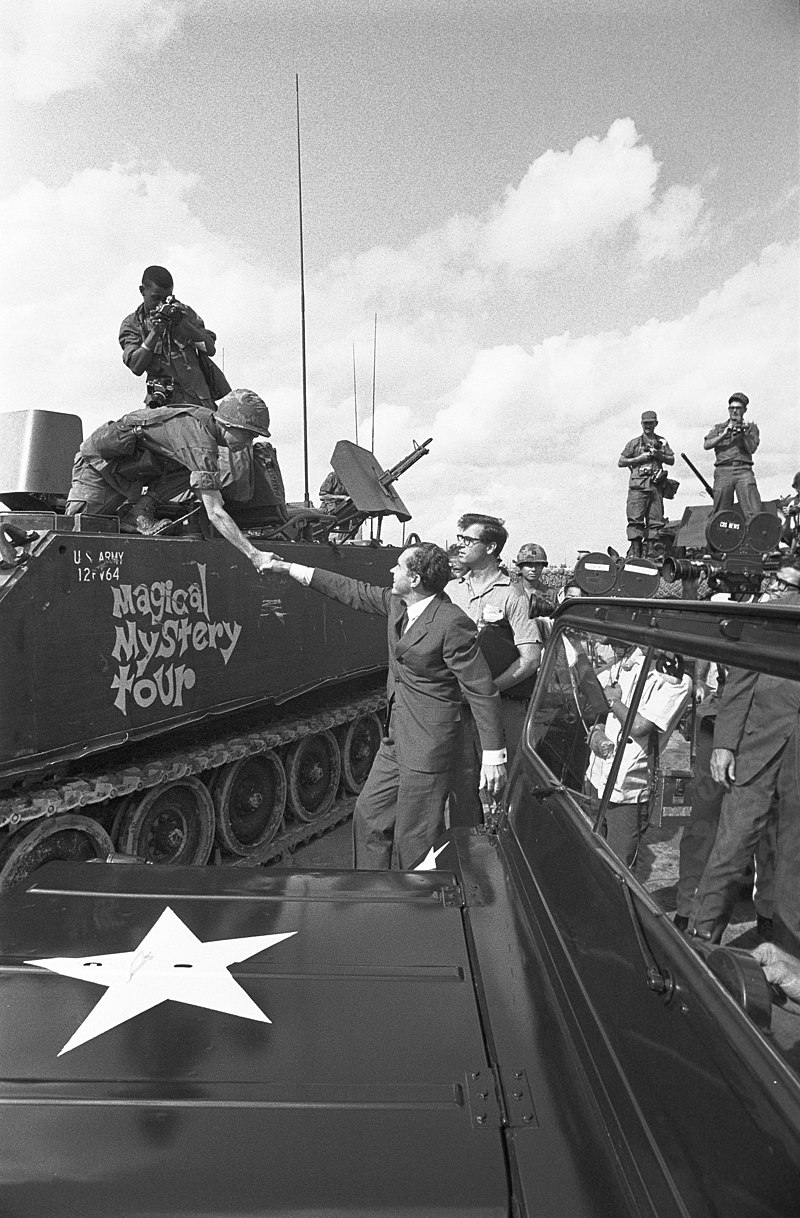
- In 1971, Nixon proposed a health insurance reform consisting of a private health insurance employer mandate, support for health maintenance organisations, and the federalisation of Medicaid for low-income families with dependent minor children.
WATERGATE SCANDAL
- During the Vietnam War, the US could not assist South Vietnam due to the 1973 Case-Church Amendment that prevented the country from engaging in military activity in Cambodia, Laos or Vietnam. Moreover, the US government was facing the Watergate scandal at that time, which led to Nixon’s resignation in 1974.
- On 17 June 1972, five burglars were arrested at the office of the Democratic National Committee in the Watergate complex of buildings in Washington, DC. After some initial investigations, it was discovered that the intruders were connected to Nixon’s re-election campaign.
- The burglars were caught wiretapping phones and stealing important documents. Nixon’s involvement in the scandal was discovered in August 1974. After the national scandal was revealed, Nixon resigned on 9 August 1974. He was replaced by his vice president, Gerald Ford.
- Nixon’s aggressive tactics of wiretapping phones and stealing classified documents related to his re-election turned out to be an illegal act of espionage. In August 1972, Nixon delivered a speech swearing that his staff at the White House were not involved in the scandal. Most voters believed him, and he was elected for a second term.
- Aside from the break-in, his tactic to impede the Federal Bureau of Investigation’s (FBI) investigation through the CIA was an abuse of presidential power and an obstruction of justice. In January 1973, two of Nixon’s aides were convicted, while five pleaded guilty to avoid trial. White House counsel John Dean testified to Nixon’s crime before the jury.
- On 24 July 1974, the US Supreme Court ordered the release of a tape recording of a conversation between Richard Nixon and his chief of staff, H.R. Haldeman, in the Oval Office on 23 June 1972.
- Known as the Smoking Gun, it is believed that the conversation occurred after the Watergate break-in. The release of the tape led to Nixon’s resignation.
Resignation
- Given the decline in political backing and the high probability of his impeachment and subsequent removal from office, President Nixon tendered his resignation on 9 August 1974 after delivering a televised speech to the country the preceding evening.
- The resignation speech was broadcast live on radio and television from the Oval Office. Nixon resigned in the nation’s interest and urged the country to endorse the incoming president, Gerald Ford. Nixon proceeded to evaluate the achievements of his presidency, particularly in the realm of foreign affairs.
LIFE AFTER PRESIDENCY
- After his resignation, Nixon and his family immediately relocated to La Casa Pacifica in San Clemente, California. However, Nixon’s resignation did not extinguish the prevailing desire among numerous individuals to witness his punishment.
- The Ford White House deliberated on the possibility of granting Nixon a pardon despite its potential unpopularity throughout the nation. Nixon, when contacted by Ford emissaries, initially displayed hesitancy in accepting the pardon but then consented to it.
- Nixon contracted phlebitis in October 1974. After being informed by his doctors that he had two options: have surgery or face death, Nixon reluctantly opted for surgery.
- Nixon was hospitalised throughout the 1974 midterm elections, and the Republican party suffered a loss of 49 seats in the House and four seats in the Senate due to the Watergate scandal and the pardon.
- In December 1974, President Nixon initiated strategising his resurgence despite the substantial animosity directed towards him inside the nation. Nixon’s health was showing signs of improvement by early 1975.
- Nixon was disbarred by the New York State Bar Association in 1976 due to his involvement in the Watergate affair, which constituted obstruction of justice. He opted not to provide any form of defence. In the first months of 1978, the individual in question embarked on a journey to the United Kingdom, during which he encountered rejection from American diplomats, most ministers within the James Callaghan government, and two former prime ministers, Harold Macmillan and Edward Heath.
DEATH
- On 18 April 1994, Nixon experienced a profound stroke while getting ready to have supper at his residence in Park Ridge, New Jersey. The patient experienced the formation of a blood clot in the upper heart as a consequence of long-term atrial fibrillation, which subsequently detached and metastasised to the brain.
- On 27 April 1994, the funeral of President Nixon was held at Yorba Linda, California. Following the demise of President Nixon, the news media extensively covered the Watergate scandal and the subsequent resignation, albeit predominantly presenting a favourable portrayal of the former president.
- Nixon’s burial site was adjacent to his spouse, Pat, in the Nixon Library. His two daughters, Tricia and Julie, and four grandkids survived him. Consistent with his expressed preferences, the funeral ceremony did not adhere to the traditional state funeral format.
Frequently Asked Questions
- Who was Richard Nixon?
Richard Nixon was the 36th Vice President under Dwight D. Eisenhower before becoming the 37th President of the United States, serving from 1969 until his resignation in 1974.
- What are some major accomplishments of Richard Nixon's presidency?
Some major accomplishments include opening diplomatic relations with China, signing arms control agreements with the Soviet Union, and ending U.S. involvement in the Vietnam War.
- What was the Watergate scandal?
The Watergate scandal involved a break-in at the Democratic National Committee headquarters at the Watergate complex in Washington, D.C., and subsequent attempts to cover up the administration's involvement. It ultimately led to Nixon's resignation.
